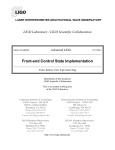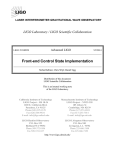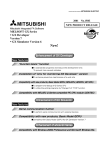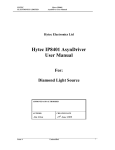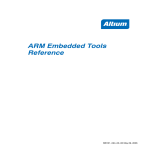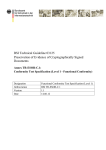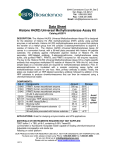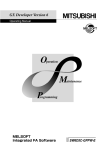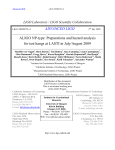Download ISC End Station User`s Manual - DCC
Transcript
LASER INTERFEROMETER GRAVITATIONAL WAVE OBSERVATORY LIGO Laboratory / LIGO Scientific Collaboration Advanced LIGO LIGO-T1300958 3/3/2013 Front-end Control State Implementation Stefan Ballmer, Chris Wipf, Daniel Sigg Distribution of this document: LIGO Scientific Collaboration This is an internal working note of the LIGO Laboratory. California Institute of Technology LIGO Project – MS 18-34 1200 E. California Blvd. Pasadena, CA 91125 Phone (626) 395-2129 Fax (626) 304-9834 E-mail: [email protected] Massachusetts Institute of Technology LIGO Project – NW22-295 185 Albany St Cambridge, MA 02139 Phone (617) 253-4824 Fax (617) 253-7014 E-mail: [email protected] LIGO Hanford Observatory P.O. Box 159 Richland WA 99352 Phone 509-372-8106 Fax 509-372-8137 LIGO Livingston Observatory P.O. Box 940 Livingston, LA 70754 Phone 225-686-3100 Fax 225-686-7189 http://www.ligo.caltech.edu/ LIGO LIGO-T1300958-v2 Table of Contents 1 Introduction ................................................................................................... 3 2 Front-end Operation ..................................................................................... 4 3 2.1 Operational Mode ............................................................................................ 4 2.2 Global State Machine ...................................................................................... 4 Control File Format....................................................................................... 5 3.1 General Remarks ............................................................................................ 5 3.2 Example ........................................................................................................... 6 3.3 XML Representation ....................................................................................... 6 3.3.1 Header ....................................................................................................... 8 3.3.2 ControlStateDef Tag .................................................................................. 8 3.3.3 Table Tag................................................................................................... 8 3.3.4 Table Initialization ...................................................................................... 9 3.3.5 Global State Machine................................................................................. 9 3.3.6 State Tag ................................................................................................. 10 3.3.7 Assign Tag ............................................................................................... 10 3.4 Redefinition Rules ........................................................................................ 12 4 GUI for Editing the Configuration File ...................................................... 13 5 Other Remarks ............................................................................................ 13 2 LIGO LIGO-T1300958-v2 1 Introduction The purpose of this document is to define a workflow which reduced the exposed complexity of the LIGO front-end models. It is not a state machine or an active controls system, but tries to simplify the exposed control complexity of a front-end system by defining a number of state control variables which in turn define the state of a large number of EPICS parameters. Looking at an auto-centering servo we typically have two quadrant detectors with four input filters each, followed by sum, pitch and yaw calculation. These values are then processed by two 2x2 input matrices, 4 servo filter bands, two 2x2 output matrix and actuation filters. This exposes a vast array of EPICS control channels to the user. Most of them have fixed values and never change, some of them may change in a scripted way and a few are adjustable. From a user point of view most of this complexity is unwanted. The possible control states are only a few. In the simplest case, it just consists of servo on or servo off. All of the filter banks typically have fixed states, so do the input and output matrices. There may be an adjustable threshold to determine the minimum light power on a quadrant detector. This is then used to determine when to operate the auto-centering servo. The idea proposed here is to define a small set of state control variables using a configuration file. The configuration file will list the available states for each control variable. It will further define whether a value is fixed or adjustable. If it is a fixed value, it will define it. Since we are dealing with a configuration file which can be loaded at run-time, values are not hard coded in the frontend model. Changes are no more difficult than loading a new filter. We will have the same version and configuration control as with “foton” filter files, i.e. the files will get archived whenever they get loaded to the front-end. Channels which are controlled by a state control variable can no longer be changed by the user directly. Using EPICS, they become effectively read-only channels. This poses a problem for commissioning, since being able to change a state on-the-fly and run a test is an important diagnostics tool. We therefore recommend that each control state has two predefined states: Default and Manual. The default state also serves as a safe state and is the default state after booting. Additional states such as Auto-center and Hold can then be added by the user. To facilitate large front-end systems which contain multiple subtasks, we also propose to implement sub-state control variables. An ISC system may contain an auto-centering part, and ALS part and an LSC part. Each part can then define one or more sub-state control variables. Meaning, the auto-centering servo can have its own state control variable which is independent from the other parts. The guardian control software now has a much easier task. No longer does it have to watch a large number of channels just to make sure they are in the right state. Active controls is also simplified. Instead of setting numerous control values synchronously to instigate a state change, only a few control variables have to be set. The guardian control software still has the task to recognize error conditions, deduced lock states, inform the user and put the system into the desired state. Summarizing, this document proposes to implement front-end control states to significantly reduce the complexity of tracking, saving and referencing the interferometer status. This will provide an effective status system, implemented directly in the front-end systems whenever possible. 3 LIGO LIGO-T1300958-v2 2 Front-end Operation 2.1 Operational Mode • The front-end to EPICS-server channel interface will include an additional check against the configuration file. This check could be implemented on either front-end or EPICS server side. An implementation as part of the EPICS server side has the advantage that the same code could be used for controlling both front-end and Beckhoff applications. • The desired state is commanded via additional EPICS channels specified in the configuration file (one or more to command the main state(s), additional ones to command every sub-state. • If the commanded main model state specifies a value for a given EPICS channel, the value from the configuration file will be used in the front-end, and fed back to EPICS as a readonly variable. • If the commanded main model state specifies a sub-state for a given EPICS channel, the value corresponding to the commanded sub-state will be used, and fed back to EPICS as a read-only variable. • If the commanded main model state specifies manual operation for a given EPICS channel, the channel value provided by EPICS will be used. • The configuration file can be read from disk upon request or on boot-up (like the current foton file). On boot-up the initialization values will be loaded. • Upon loading the configuration file, a copy of the file is archived. • The main and sub-state can be commanded through dedicated EPICS variables specified in the configuration file. 2.2 Global State Machine The program responsible for commanding the control states is itself a state machine. It has the following states: • Init (1): The system is initializing. No hardware access is performed. • Preop (2): The system is ready to run and access to the hardware is active. EPICS channels are manually accessible, but the controls state definitions are not enforced. • SafeOp (4): The system is in a safe operating mode. Access to the hardware is active. The controls state definitions are enforced, but all tables are held in their initialization state. • Op (8): The system is running normally. Access to the hardware is active. The controls state definitions are enforced, and the tables can transition to any of their predefined states. These additional flags are available: • Error (16): This indicates an error has occurred if reported by the readback channel. It is interpreted as a request to clear the error when specified in the request channel. 4 LIGO • LIGO-T1300958-v2 Configure (32): This indicates that the configuration file(s) are getting read if reported by the readback channel. It is interpreted as a reconfiguration request when specified in the request channel. The global state machine employs two controls channels: • • (BASENAME)_STATE: This is the readback channel of the global state machine indicating its actual state. It is read-only. (BASENAME)_REQUEST: This is the request channel of the global state machine which can be used to request a transition to a new state or an action. 6 After start up the global state machine is set to the initialization state, while the requested state is set to restart. The restart option is a combination of mode bits and flags. Transitions are only allowed between adjacent states. A restart request from the initialization state will first clear any errors, secondly read the configuration file and finally transition to Preop, SafeOp and Op in sequence. Similarly, if the system is in Op mode, it has to first transition through SafeOp to reach the PreOp state. If multiple modes and flags are selected in a request, the system will first transition to the lowest indicated state. There, it will perform any actions indicated by the flags. An error will always be cleared before reading a new configuration. Finally, the system will try to transition to the highest indicated state. If an error occurs and the system is in Op mode, it will transition back to SafeOp and set the error flag. If the error is due to a hardware access fault, the system will transition all the way back to the initialization state. With the exception of the startup a transition to a higher state always requires a user input. 3 Control File Format 3.1 General Remarks • The file lists every EPICS channel used by the front-end model, with filter-module-related channels and matrix-related channels grouped together. • The IFO name will be omitted in the channel list, allowing copying files between interferometers. • For editing a dedicated GUI (like foton) will be written. • The file will include tables to define the main state(s) and sub-states. • In a main state table, a initialization values have to be specified. Channels not listed in any initialization list will default to zero, and will be read-only in any state other than 0 (off). • State 0 (off) and state 1 (default) always exist. An arbitrary number of additional states can be defined. • In the main state table, for each state and for each EPICS channel one of the following has to be specified: 1) a value, or 2) manual operation through EPICS, or 3) a pointer to the relevant sub-state table. 5 LIGO LIGO-T1300958-v2 • An arbitrary number of sub-state tables can be provided. Unlike the main state tables, they do not have to list all channels in an initialization list. • In the sub-state table, for each sub-state and for each involved EPICS channel one of the following has to be specified: 1) a value, or 2) manual operation through EPICS. • For binary channels “manual” mode can be commanded for every bit individually. This is done via a manual mask. • In addition to the default state and the user-defined states, an off or manual state is implicitly defined. It's state number is zero (0). For it, all channels default to “manual”. 3.2 Example LSC-MASTERSTATE Channel name INIT 0: OFF 1: DEFAULT 2: RUN LSC-DARM_GAIN 1 manual 2 3 LSC-DARM_SW1S 0xFF manual 0x33 (Mask: 0xF3) 0x33 (Mask: 0xF3) LSC-CARM_GAIN 0 manual manual manual LSC-MICH_GAIN 0 manual See INIT (0) Sub state LSCGAINSTEPPING LSC-GAINSTEPPING Channel name 0: OFF 1: DEFAULT 2: STEP A 3: STEP B LSC-MICH_GAIN manual See default above 1 2 3.3 XML Representation We are using an xml file format. Taking the example table above and adding a few channels, it will look like: 6 LIGO LIGO-T1300958-v2 <?xml version="1.0" encoding="UTF-8" standalone="no"?> <!--This is a configuration file of the LIGO project!--> <ControlStateDef xmlns:p="https://dcc.ligo.org/LIGO-T1300958/public" Target="lsc"> <Assign Name="LSC-REFL_A_RF45_I_GAIN">1.2</Assign> <Assign Name="LSC-REFL_A_RF45_Q_GAIN" Type="man">1.2</Assign> <Table Name="LSC-MASTERSTATE" Type="main" Location="internal"> <Assign Name="LSC-DARM_GAIN">1</Assign> <Assign Name="LSC-DARM_SW1S">0xF3</Assign> <Assign Name="LSC-CARM_GAIN">0</Assign> <Assign Name="LSC-MICH_GAIN">0</Assign> <State Number="0" Name="Off" Ramp="0"/> <State Number="1" Name="Default"> <Assign Name="LSC-DARM_GAIN" Type="val" >2</Assign> <Assign Name="LSC-DARM_SW1S" Type="val" Mask="0xF3"> 0x33 </Assign> <Assign Name="LSC-CARM_GAIN" Type="man"/> </State> <State Number="2" Name="RUN"> <Assign Name="LSC-DARM_GAIN" Type="val" RAMP="3.0">3</Assign> <Assign Name="LSC-DARM_SW1S" Type="val" Mask="0xF3">0x33</Assign> <Assign Name="LSC-CARM_GAIN" Type="man"/> <Assign Name="LSC-MICH_GAIN" Type="sub"> LSC-GAINSTEPPING </Assign> </State> </Table> <Table Name="LSC-GAINSTEPPING" Type="sub" Location="internal"> <State Number="0" Name="Off"/> <State Number="1" Name="Default"/> <State Number="2" Name="STEP A" RAMP="1.0"> <Assign Name="LSC-MICH_GAIN" Type="val">1</Assign> </State> <State Number="3" Name="STEP B" RAMP="1.0"> <Assign Name="LSC-MICH_GAIN" Type="val">2</Assign> </State> </Table> </ControlStateDef> 7 LIGO LIGO-T1300958-v2 3.3.1 Header The XML header is as follows: <?xml version="1.0" encoding="UTF-8" standalone="no"?> <!--This is a configuration file of the LIGO project!--> 3.3.2 ControlStateDef Tag This tag describes the top level container. Attribute Target: Contains the real-time model name for which the file specifies states, without the interferometer name. Examples: lsc, asc, susbs Attribute xmlns:p: Specifies XML namespace. The name space points to the current version of this document. It should be set to https://dcc.ligo.org/LIGO-T1300958/public. 3.3.3 Table Tag This tag describes a controlled state. Attribute Name: Specifies the name of the EPICS channel controlling the states defined in this table. Attribute Type: The choices are “main” or “sub”. The default is “main”, if omitted. Defines whether the table specifies a main state or a sub state Attribute Location: The choices are “internal” or “external”. For “internal” the controlling EPICS channel is created in the EPICS server, and it is not accessible by the front-end itself. For “external” the channel has to be defined in the front-end, and thus is accessible by the front-end. For tables of type “main”: Every table of type “main” has at least a State 0 (off/manual) and a State 1 (default state). If not listed explicitly, the settings in state 1 correspond to the initialization values. During initialization the table will be set to state 1, when not defined in the global state machine. The default value can be overwritten by explicitly listing the table name in global state machine and define an Op value. The SafeOp value is also 1 by default, but again can be overwritten in the global state machine. Multiple tables of type “main” are permissible, but their channel lists as defined in the initialization section must be disjoint. If a channel is neither listed in the initialization section of a table of type “main” or at the top level, its value is set to 0 and not changeable in any state. For tables of type “sub”: The State 1 of a table of type “sub” is implicitly defined as being equal to the State 1 of the main table pointing to it. However, this implicit definition can be overwritten by explicitly defining a state 1. Attribute Ramp: Defines the default ramp time in seconds for switching values within the table. If omitted, values are changed immediately. Ramp times are not used during initialization. 8 LIGO LIGO-T1300958-v2 3.3.4 Table Initialization An Assign tag located inside the Table but outside a State tag is treated as a default value. Any state which does not define its own assignment for a channel, takes its value from the default. This is only allowed for a table of type “main”. It can only contain Assign tags of type “val” or “man” (see below). If it is defined as “val”, its value is used for the default value. When it is defined as “man”, the default is defined as manual. If no special SafeOp value is defined within the global state machine (see below), the default value also serves as the SafeOp value. A special case is an assignment of type “man” which also has an associated valid value. In this case the default value is defined as manual, whereas the SafeOp value is derived from the specified value. If the SafeOp value is indented to be manual, but the default value is of type “val”, the tag needs a separate assignment within the SafeOp state of the global state machine using the type “man”. The ramp time for SafeOp values derived from table initialization is 0. An non-zero ramp value for SafeOp values, requires a definition within the global state machine. The initialization list must define all channels associated with a “main” table. No exception! Any tag that is neither listed in the initialization list of a “main” table nor at the top level, is set to and kept at zero (0). If a tag is listed with type “val”, but has no explicit value, it is assumed to be zero (0), false (bit) or an empty string depending on the type. 3.3.5 Global State Machine The global state machine can be referenced explicitly by defining a table of type “top”. A table of type “top” has the following predefined states: State 1 (Init), State 2 (PreOp), State 4 (SafeOp) and State 8 (Op). These states cannot be overwritten or extended. Explicitly defining the global state machine makes the associated controls channels accessible by EPICS. The table name is used to define the base name of the controls channel. Assign statements can only be listed for state 4 (SafeOp) and state 8 (Op). These are the only states where the state definitions are enforced, and thus the assignments associated for all other modes of the global state machines are irrelevant. Table initialization outside the state definition is also possible. It has similar meaning to normal tables. A value assignment of type “val” is treated as a constant and the value is set to a fixed value for both SafeOp and Op modes. A value assignment of type “man” with a specified value is set to a fixed value in SafeOp but left alone in Op mode. A value assignment of type “man” without a specified value is left alone and ignored in all states. A global initialization is an assignment tag outside any table definition. It is treated exactly like a table definition inside the “top” table. 9 LIGO LIGO-T1300958-v2 3.3.6 State Tag This tag describes an individual control state. Attribute Number: This specifies the number of a state. This corresponds to the selection value of the controlling EPICS channel (specified in the attribute Name). The number zero (0) is reserved for the off/manual state. The number one (1) is reserved for the default state. Negative numbers are not allowed. If all the state numbers are equal or below 15, an EPICS mbbo record will be used. If at least one state value is larger than 15, an EPICS longout record will be used. Attribute Name: This specifies the name of the state. This will be used to define the EPICS value type for mbbo records. For EPICS longout records the name is ignored. Channels can be reassigned inside a state. Omitting a channel name implies inheriting the settings from the initialization section. The State 1 (default state) of a table of type “sub” is implicitly defined as being equal to the State 1 (default state) of the main table pointing to it. However this implicit definition can be overwritten by explicitly defining a state 1. Channels in State 1 (default state) can have manual entries and Mask fields. However this should be used sparsely, and only where needed. An example might be alignment sliders, whose good settings can change from day to day. State 0 (off) is special. In this state all channels will default to manual mode unless specified otherwise. Attribute Ramp: Defines the default ramp time in seconds for switching values within the state. If omitted, values are changed immediately. Ramp times cannot be specified for initialization. Ramp times specified by a state override the one specified by a table. 3.3.7 Assign Tag The Assign tag is used to assign values to channel names. When defined under ControlStateDef, it denotes a global constant (using type “val”) or a manual value (using type “man”). A manual value is used to initialize the channel, but is then left in manual mode. When defined inside a table, it denotes an initial and default value for a channel. When defined under a state, it defines the value associated with a state. A channel with its optional bit mask can be defined exactly once under a table. It can be redefined inside multiple state tags of the same table, or in an associated sub state table. When defined at the top level, it cannot be redefined inside a table. When defined inside a table, it cannot be redefined in another table. Assign tags with the same channel name but a different bit mask are treated as different entities. If a bit mask is used, it has to match when a channel entity is reassigned inside the different states of a table. Attribute Name: This specifies the name of a channel, but without the interferometer prefix, e.g., LSC_DARM_GAIN or LSC_DARM_SW2S. 10 LIGO LIGO-T1300958-v2 Attribute Type: The choices are either “val”, “man” or “sub”. The default, if omitted, is “val”. Specifies the type of assignment made to the specified channel in the specified state. The keyword “sub”, implies that a sub state Table is defined which in turn will redefine the value. Attribute Mask: This specifies a binary mask (up to 32 bits) for the channel. If a mask is used, it has to be repeated in all associated assignments. A channel can be split into multiple entities which have non-overlapping bit masks. Multiple entities of the same channel are for all practical purposes treated like separate channels. Bits of a channel which are defined nowhere, are set and kept at zero. Omitting the Mask attribute implies that no mask is applied, i.e. all bits of the data field are used. With this definition a mask of 0 (no mask) and 0xFFFFFFFF (all bits used) are identical in purpose. A mask can be defined as a decimal, octal or hexadecimal number. The data field of an Assign tag contains the following: For Type=“val”, any of the following: • Floating point number (e.g. 58.1, or 58E0) • Decimal number (e.g. 58) • Octal number (e.g. 072) • Hexadecimal number (e.g 0x3A) • Boolean value: true or false • A sting in quotes, indicating an EPICS field enum value (e.g. “inactive” or “off”), or a string value. For type “man”, the data field is either used as an initialization value or ignored. For type “sub”, the data field specifies the sub-table channel name which is used to define this channel (no quotes). This is only permitted in a table of type “main”. It is not permitted in state 1 (default state). Omitting the data field for type “val” is equivalent to specifying 0 in the data field. Attribute Ramp: Defines the ramp time in seconds for changing to the assigned value. Ramp times only makes sense for value assignments. The value is ramped linearly from the previous one to the newly specified one, when the state is changed. Tables can specify a default ramp time which is used to switch all values used in the table. If a state specified a different ramp time, it gets precedence over the table ramp time. Finally, a ramp time specified as part of an assignment takes precedence over all others. The ramp time of a value is set at the time the assignment is encountered. This is an important distinction, if the assignment is redefined later. 11 LIGO LIGO-T1300958-v2 3.4 Redefinition Rules The following rules apply when parsing one or more control state definition files: • Multiple ControlStateDef tags can be defined within a single file, or in multiple files. • If multiple ControlStateDef tags are defined within a file, they should have a different target. If the same target name is used, the tables, states and assignments of the later definition will be added to the first. • Generally, it is expected that each table definition has a unique name. If a later table has the same name, its states and assignments are added to the first table. It is treated as a simple reiteration. • If a table is redefined within the same ControlStateDef tag, it should have the same type and location. If not, the later definition overwrites the previous one. • If a table is redefined across multiple ControlStateDef tags, their location needs to be identical. • If a table is redefined with a different type, the later definitions are ignored. • Two state definitions are considered identical, if they are associated with the same table and if they have the same number. If a state is redefined with a different name, the later name is ignored. • An assignment defines a tag. Two tags are considered identical, if there name and mask are the same. Tags are unique, if they either have different names, or if they have nonoverlapping bit masks and identical names. • Tags which are neither identical nor unique have the same name and overlapping bit masks. They are a mistake and result in undefined behavior. • Tags are generally reiterated in different states of the same table. This results in different values depending on the state of system. A tag can also be reiterated in a different table, if the first table is of type “main” and the others are of type “sub”. • If a tag is redefined within the same table and state, the later definition overwrites the previous one. • A tag which is defined in a table of type “sub”, but is never defined in a table of type “main” is lost and will be ignored. • However, it is a mistake to redefine a tag across different tables of type “main”. Or, to redefine a tag in a table when it has already be defined as a global constant. When conflicting tag definitions are present, all but one of the definitions will be ignored. Generally, redefining a table or a state should be avoided. In a some cases, it may make sense to have a global control state definition file and keep site specific variations contained in separate files. Within the same file, it almost never makes sense to redefine a table or a state. Overwriting a previous tag has similar implications. Good practice is to keep the definitions of tables, states and tags within the same group to avoid confusion. 12 LIGO LIGO-T1300958-v2 4 GUI for Editing the Configuration File • The GUI provides an easily clickable graphical interface for setting the filter modules. (Using “ezcaswitch” logic - not “ezcawrite” logic) • The GUI provides a formatted matrix interface of system matrices • The GUI provides a bitmap interface of configuring binary control channel. • For all other channels the GUI allows entering the value. • “manual” or “substate” mode has to be command-able on a “per bit”, “per FMx block”, “per ON/OFF switch” or “per value” basis. • In addition to basic edit functions, the GUI allows copying existing states. 5 Other Remarks • On compilation the front-end code provides the list of channels and updates the existing configuration file. • On compilation new, previously non-existing channels will be we set to a value 0 (off or disabled). In particular, active user action in the GUI will be need to define a channel as “manual”. • Upon restart the front-end code will load the initialization values and default to the “default” state. • Same infrastructure for Front-end and Beckhoff: Beckhoff-EPICS interface will be upgraded to be able to parse the same format of state files for Beckhoff's EPICS channels. 13













